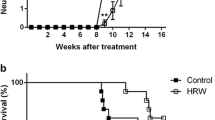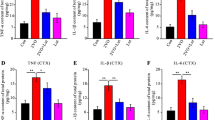Abstract
Oxidative stress has an important role in neuronal damage during cerebral ischemia and can lead to cognitive and behavioral impairment. Alpha-tocopherol, a powerful antioxidant, may be able to preserve neuronal tissue and circumvent neurological deficits. Thus, this study aimed to investigate the influence of alpha-tocopherol in the preservation of brain tissue and the maintenance of memory formation in stroke-prone spontaneously hypertensive rats (SHRSP). To achieve this aim, twenty-four 15-week-old male SHRSP rats were separated into the following four groups (n = 6 each) that received different treatments over a 4-week period: the alpha-tocopherol group, the control group, the L-NAME group, and the L-NAME + alpha-tocopherol group. We evaluated the physiological parameters (body weight, diuresis, and food and water intake), an oxidative stress marker (malondialdehyde levels), and neurological responses (the Morris Water Maze and Novel Objects Recognition tests). Afterwards, the brains were removed for histopathological analysis and quantification of the number of cells in the hippocampus. Statistically, the alpha-tocopherol group demonstrated better results when compared to all groups. The data indicated a reduction in oxidative stress and the preservation of neurological responses in groups treated with alpha-tocopherol. In contrast, the L-NAME group exhibited increased malondialdehyde levels, impairment of neurological responses, and several hippocampus tissue injuries. The others groups exhibited nerve tissue changes that were restricted to the glial nodes. No significant alterations were observed in the physiologic parameters. Based on these findings, we suggest that alpha-tocopherol can prevent stroke, preserve the structure of the hippocampus, and maintain both memory and cognition functions.






Similar content being viewed by others
References
Allami N, Javadi-Paydar N, Rayatnia F et al (2011) Suppression of nitric oxide synthesis by L-NAME reverses the beneficial effects of pioglitazone on scopolamine-induced memory impairment in mice. Eur J Pharmacol 650:240–248
Alzoubia KH, Khabourb OF, Rashida BA et al (2012) The neuroprotective effect of vitamin E on chronic sleep deprivation-induced memory impairment: the role of oxidative stress. Behav Brain Res 226:205–210
Aradillas E, Libon DJ, Schwartzman RJ (2011) Acute loss of spatial navigational skills in a case of a right posterior hippocampus stroke. J Neurol Sci 308(1–2):144–146
Azzi A, Ricciarelli R, Zingg JM (2002) Non-antioxidant molecular functions of alpha-tocopherol (vitamin E). FEBS Lett 519:8–10
Brijesh R, Ravindran GA (2007) Spiking neural network of the CA3 of the hippocampus can be a neural prosthesis for lost cognitive functions. Conf Proc IEEE Eng Med Biol Soc 4:755–758
Chen J, Zacharek A, Zhang C et al (2005) Endothelial nitric oxide synthase regulates brain-derived neurotrophic factor expression and neurogenesis after stroke in mice. J Neurosci 25:2366–75
Comin D, Gazarini L, Zanoni JN et al (2010) Vitamin E improves learning performance and changes the expression of nitric oxide-producing neurons in the brains of diabetic rats. Behav Brain Res 210:38–45
Crouzin N, Ferreira MC, Cohen-Solal C et al (2010) Neuroprotection induced by vitamin E against oxidative stress in hippocampal neurons: involvement of TRPV1 channels. Mol Nutr Food Res 54:496–505
Cuppini R, Ciaroni S, Cecchini T et al (2002) Tocopherols enhance neurogenesis in dentate gyrus of adult rats. Int J Vitam Nutr Res 72:170–6
Ducruet AF, Sosunov SA, Visovatti SH et al (2011) Paradoxical exacerbation of neuronal injury in reperfused stroke despite improved blood flow and reduced inflammation in early growth response-1 gene-deleted mice. Neurol Res 33:717–725
Emmrich P, Hahn J, Ogunlade V et al (2003) Neuropathological findings after cardiac surgery-retrospective study over 6 years. Z Kardiol 92:925–937
Faraji J, Metz GA, Sutherland RJ (2011) Stress after hippocampal stroke enhances spatial performance in rats. Physiol Behav 102(4):389–399
Ferri P, Cecchini T, Ambrogini P et al (2006) Alpha-tocopherol effects neuronal plasticity in adult rat dentate gyrus: the possible role of PKCdelta. J Neurobiol 66:793–810
Fredriksson K, Nordborg C, Kalimo H et al (1988) Cerebral microangiopathy in stroke-prone spontaneously hypertensive rats. An immunohistochemical and ultrastructural study. Acta Neuropathol 75:241–252
Furini CR, Rossato JI, Bitencourt LL et al (2010) Adrenergic receptors link NO/sGC/PKG signaling to BDNF expression during the consolidation of object recognition long-term memory. Hippocampus 20:672–683
Harooni HE, Naghdi N, Sepehri H et al (2009) The role of hippocampal nitric oxide (NO) on learning and immediate, short- and long-term memory retrieval in inhibitory avoidance task in male adult rats. Behav Brain Res 201:166–172
Hernández-Pinto AM, Puebla-Jiménez L, Arilla-Ferreiro E (2009) Alpha-tocopherol decreases the somatostatin receptor-effector system and increases the cyclic AMP/cyclic AMP response element binding protein pathway in the rat dentate gyrus. Neuroscience 162:106–17
Izquierdo I, Medina J (1997) Memory formation: the sequence of biochemical events in the hippocampus and its connection to activity in other brain structures. Neurobiol Learn Mem 68:285–316
Kayden HJ, Traber MG (1993) Absorption, lipoprotein transport, and regulation of plasma concentrations of vitamin E in humans. J Lipid Res 34:343–358
Kim EM, Elliot JJ, Hobson P et al (2009) Effects of intrahippocampal injections on memory in the rat and attenuation with vitamin E. Prog Neuropsychopharmacol Biol Psychiatry 33:945–51
Kishi T, Hirooka Y, Kimura Y (2004) Increased reactive oxygen species in rostral ventrolateral medulla contribute to neural mechanisms of hypertension in stroke-prone spontaneously hypertensive rats. Circulation 109:2357–2362
Leinonen JS, Ahonen JP, Lönnrot K et al (2000) Low plasma antioxidant activity is associated with high lesion volume and neurological impairment in stroke. Stroke 31:33–9
Minami M, Togashi H, Koike Y (1985) Changes in ambulation and drinking behavior related to stroke in stroke-prone spontaneously hypertensive rats. Stroke 16:44–48
Morris RGM (1984) Developments of a water-maze procedure for studying spatial learning in the rat. J Neurosci Methods II 47–60
Mumby D (2005) Object Recognition. In: Whishaw IQ, Kolb B (eds) The behavior of the laboratory rat, sect. 36. Oxford University Press, New York, pp 383–91
Murad LB, Guimarães MRM, Vianna LM (2011) Alpha-tocopherol protects against memory impairment caused by L-NAME and modulates the injury marker and blood coagulant parameters. Biofactors 37:315–22
Nikonenko AG, Radenovic L, Andjus PR et al (2009) Structural features of ischemic damage in the hippocampus. Anat Rec 292:1914–1921
Raza SS, Khan MM, Ashafaq M et al (2011) Silymarin protects neurons from oxidative stress associated damages in focal cerebral ischemia: a behavioral, biochemical and immunohistological study in Wistar rats. J Neurol Sci 309:45–54
Ricciarelli R, Zingg JM, Azzi A (2002) The 80th anniversary of vitamin E: beyond its antioxidant properties. Biol Chem 383:457–465
Sato H, Takahashi T, Sumitani K et al (2010) Glucocorticoids generates ROS to induce oxidative injury in the hippocampus, leading to impairment of cognitive function of rats. J Clin Biochem Nutr 47:224–232
Schreiber S, Bueche CZ, Garz C et al (2012) The pathologic cascade of cerebrovascular lesions in SHRSP: is erythrocyte accumulation an early phase? J Cereb Blood Flow Metab 32(2):278–90
Shimada IS, Borders A, Aronshtam A et al (2011) Proliferating reactive astrocytes are regulated by notch-1 in the peri-infarct area after stroke. Stroke 42:3231–3237
Snider BJ, Du C, Wei L et al (2001) Cycloheximide reduces infarct volume when administered up to 6 h after mild focal ischemia in rats. Brain Res 917:147–57
Sun L, Zhou W, Mueller C et al (2010) Oxygen therapy reduces secondary hemorrhage after thrombolysis in thromboembolic cerebral ischemia. J Cereb Blood Flow Metab 30:1651–60
Sunil AG, Kesavanarayanana KS, Kalaivania P et al (2011) Total oligomeric flavonoids of Cyperus rotundus ameliorates neurological deficits, excitotoxicity and behavioral alterations induced by cerebral ischemic–reperfusion injury in rats. Brain Res Bull 84:394–405
Watson SN, Risling TE, Hermann PM, Wildering WC (2012) Failure of delayed nonsynaptic neuronal plasticity underlies age-associated long-term associative memory impairment. BMC Neuroscience 13:103
Wu A, Ying Z, Gomez-Pinilla F et al (2010) Vitamin E protects against oxidative damage and learning disability after mild traumatic brain injury in rats. Neurorehabil Neural Repair 24:290–298
Zucca S, Valenzuela CF (2010) Low concentrations of alcohol inhibit BDNF-dependent GABAergic plasticity via L-type Ca2+ channel inhibition in developing CA3 hippocampal pyramidal neurons. J Neurosci 30:6776–6781
Acknowledgment
All the authors contributed equally to this article. This work received support from the Brazilian national agencies for research and development CNPq and CAPES.
Conflict of interests
There were no conflicts of interests.
Author information
Authors and Affiliations
Corresponding author
Rights and permissions
About this article
Cite this article
Murad, L.B., Guimarães, M.R.M., Paganelli, A. et al. Alpha-tocopherol in the brain tissue preservation of stroke-prone spontaneously hypertensive rats. J Physiol Biochem 70, 49–60 (2014). https://doi.org/10.1007/s13105-013-0279-y
Received:
Accepted:
Published:
Issue Date:
DOI: https://doi.org/10.1007/s13105-013-0279-y




